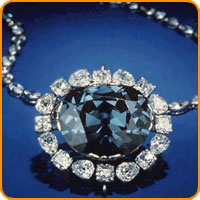 |
The Blue Hope: 45.52 carats
The 45.52 carat steel blue Hope Diamond was found in India back in remote times as a rough crystal weighing 112 carats. It first came to light when Jean Baptiste Tavernier, the noted French traveler of the 17th century, was approached in India by a slave who had a very secretive manner about him.
It turned out that he had in his possession an intriguing steel blue stone which at first look seemed to be a large sapphire, but the well-experienced Tavernier soon realized it was a Diamond - the largest deep blue Diamond in the world. |
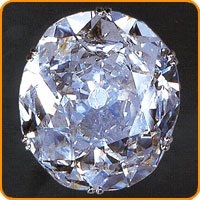 |
The Koh-I-Noor (Mountain of Light) Current Weight: 105.60 carats Original Weight: 186 carats
It has been said that whoever owned the Koh-I-Noor ruled the world, a suitable statement for this, the most famous of all Diamonds and a veritable household name in many parts of the world. Legend has suggested that the stone may date from before the time of Christ; theory indicates the possibility of its appearance in the early years of the 1300s; history proves its existence for the past two and a half centuries. |
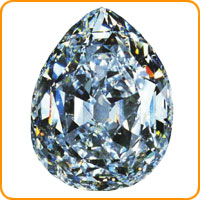 |
The Cullinan Diamonds: 3,106 carats (rough)
Royal Sceptre with Star of Africa. The stone can be removed from the Royal Scepter and worn as a pin or pendant.
The Star of Africa, a pear shaped Diamond weighing 530.20 carats, aka the Cullinan I. It measures 53mm x 44mm x 29mm, and has 76 facets (counting the culet and the table). It's called the Cullinan I because it's the largest of the 9 large stones cut from the Cullinan Diamond. The Star of Africa holds the place of 2nd largest cut Diamond in the world. It is on display with the other Crown Jewels in the Tower of London. |
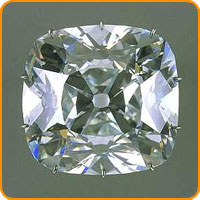 |
The Regent: 140.50 carats
The adventurous history of the Regent is very much like that of several other great Diamonds. Greed, murder and remorse play a part in the opening chapter. Trouble - political, social, and personal - accompanies this gem to it's last resting place. Originally known as the Pitt, this 410-carat stone was one of the last large Diamonds to be found in India. It is said to have been discovered by a slave in the Parteal Mines (also spelled 'Partial') on the Kistna River about 1701. |
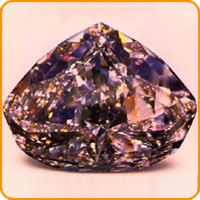 |
The Centenary: 273.85 carats
On March 11th, 1988, the centenary celebrations of De Beers took place in Kimberly and a banquet was held to close the Kimberly Mine (aka the "Big Hole"). An audience of four hundred people, including representatives of several national governments of Diamond-producing countries and dignitaries from various sections of the industry, listened to the welcoming speech of the chairman, Julian Oglivie Thompson, totally unprepared for his final sentence: "We have recovered at the Premier Mine a Diamond of 599 carats which is perfect in color - indeed it is one of the largest top-color Diamonds ever found. Naturally it will be called the Centenary Diamond." |
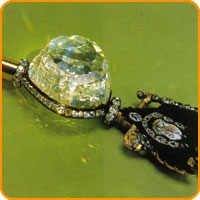 |
The Orlov: 300 carats (original rough)
Legend, fact, supposition and theory each must be accorded its place in any historical account of this celebrated Diamond. Nowadays the Orlov is one of the most important items in one of the greatest collections of gems and jewelry, the Treasures of the Diamond Fund, Gokran, cromprises of many historical jewels that were amassed by the rulers of Russia before the 1917 Revolution, as well as some of the exceptional Diamonds unearthed during the past three decades that testify to Russia's current position as a leading world Diamond producer. |
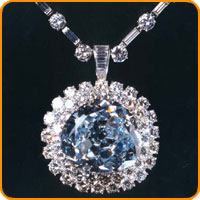 |
The Idol's Eye: 79.20 carats
The first authenticated fact in the Diamond's history was its appearance at a Christie's sale in London on July 14th, 1865, when it was described as "a splendid large Diamond known as the Idol's Eye set round with 18 smaller brilliants and a framework of small brilliants." It was knocked down to a mysterious buyer simply designated as "B.B.". Later it is stated that the 34th Ottoman Sultan, Abdul Hamid II (1842-1918) owned the Idol's Eye. |
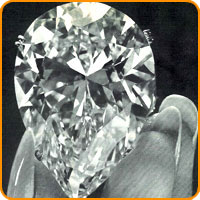 |
The Taylor-Burton: 69.42 carats
The Taylor-Burton is by far the best known of Richard Burton's purchases, a 69.42-carat pear-shape Diamond. It was a gift to his wife Elizabeth Taylor. It was cut from a rough stone weighing 240.80 carats found in the Premier Mine in 1966 and subsequently bought by Harry Winston. |
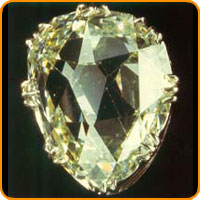 |
The Sancy: 55 carats
The Sancy Diamond has one of the most interesting, colorful, confused and involved histories of all the famous Diamonds in Europe. It is a pale yellow 55.23-carat shield-shaped stone, apparently of Indian origin, and is said to be one of the first large Diamonds to be cut with symmetrical facets. The stone is also unusual because it has no pavilion - just a pair of crowns, one on the other. |
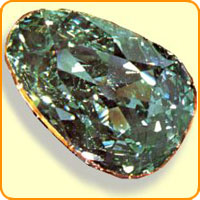 |
The Dresden Green: 41 carats
In the rough, greenish Diamonds tend to occur as one of three types: a stone, often a crystal shape, possessing a light tinge rather like the color of water in a swimming pool; a stone with a dark green skin; a yellowish-green stone characterized by a degree if lubricity. After being cut and polished, Diamonds of the first and second types usually lose their greenish color to become white gems or, alternatively, light yellow stones known as "silvery capes". The few truly green faceted Diamonds therefore originate from the third type. The famous collection of De Beers Fancy Colored Diamonds, which has been displayed throughtout the world includes some beautiful examples of green Diamonds. |
| |
| Source: The World of Famous Diamonds |
| |
